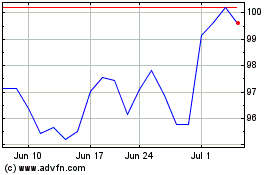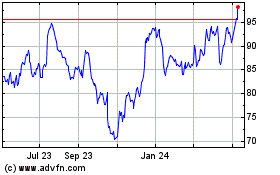Trading Powers Morgan Stanley to 45% Profit Jump -- 2nd Update
July 16 2020 - 8:35AM
Dow Jones News
By Liz Hoffman
Morgan Stanley's second-quarter earnings rose 45% during a
stretch when the coronavirus ripped through the U.S. economy and
financial markets.
The bank reported revenue of $13.4 billion and profit of $3.2
billion, or $1.96 per share, on Thursday. Both were quarterly
records for the firm and well above the expectations of Wall Street
analysts, who had predicted profit of $1.77 billion, or $1.12 per
share.
Morgan Stanley and Bank of America Corp. were the last of the
big U.S. banks to report financial results for a period that posed
the biggest test of the financial system since 2008. Results shook
out along recognizable lines: Big commercial and consumer lenders
like JPMorgan Chase & Co. and Bank of America took provisions
for loan losses that dragged down earnings, while a surge in
securities trading and underwriting favored Wall Street-heavier
firms such as Morgan Stanley and Goldman Sachs Group Inc.
"It's a testament to the business model, which we think is the
right business model for a longer period of time, but particularly
for this environment," Chief Financial Officer Jonathan Pruzan said
in an interview.
Morgan Stanley also has the country's largest wealth-management
brokerage, which brought in $4.7 billion in revenue during the
second quarter. Chief Executive James Gorman calls the unit, which
clips fees managing nearly $2.7 trillion of clients' money, a
ballast that steadies the firm while its Wall Street businesses of
deals and trades provide the power.
That engine purred in the second quarter. Morgan Stanley's
trading revenue rose 68% from the same period a year ago, more than
doubling in debt trading. Its investment bankers generated $1.6
billion in revenue helping companies sell stock and debt to the
public, two-thirds higher than a year ago.
Mr. Gorman, who himself contracted Covid-19 earlier this year,
said in a statement, "The second quarter tested the model and we
performed exceedingly well."
Mr. Pruzan said the firm had "consciously avoided consumer
credit" as well as commercial banking, which means it is less
exposed to a wave of defaults that looks increasingly likely as
much of the U.S. economy remains shut down.
The bank's return on equity, a measure of how profitably it
invests shareholders' money, rose to 15.7%, above the high end of a
target range set last year by Mr. Gorman. Morgan Stanley also
remains comfortably above a minimum capital level it will have to
hit starting this fall.
Investors will be looking for an update on Morgan Stanley's
pending acquisition of E*Trade Financial Corp., which is expected
to be completed late this year. The deal, struck just before the
pandemic hit and valued at the time at $13 billion, is meant to
bring in new clients to the firm's wealth arm, upgrade Morgan
Stanley's technology, and introduce the blue-blooded firm to a
younger generation of investors.
Though it is known for its dot-com vibe and quirky television
ads, E*Trade's crown jewel is a lower-key business: managing the
stock that employees at hundreds of companies receive as part of
their pay. Those shares are typically locked up for a few years and
when they become available, Morgan Stanley aims to move those
employees into brokerage accounts.
The deal will also bring some $38 billion in deposits. Morgan
Stanley, which doesn't have branches or traditional bank accounts,
has been trying to grow deposits as a low-cost source of funding.
That is more crucial than ever as the pandemic -- and the recession
that is likely to stretch on -- puts stress on banks' finances.
Write to Liz Hoffman at liz.hoffman@wsj.com
(END) Dow Jones Newswires
July 16, 2020 08:20 ET (12:20 GMT)
Copyright (c) 2020 Dow Jones & Company, Inc.
Morgan Stanley (NYSE:MS)
Historical Stock Chart
From Mar 2024 to Apr 2024

Morgan Stanley (NYSE:MS)
Historical Stock Chart
From Apr 2023 to Apr 2024
